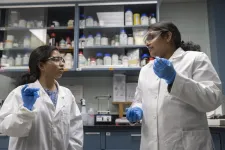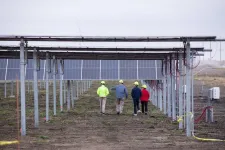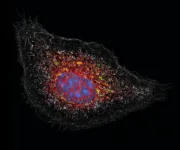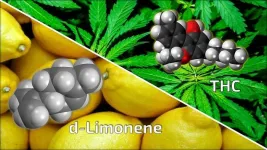(Press-News.org) (MEMPHIS, Tenn. – April 10, 2024) Infection with the influenza virus leads to lung injury through inflammation over-activation that causes collateral damage to cells required for breathing. Such damage can be life-threatening, but scientists have a new preventative treatment. A team from St. Jude Children’s Research Hospital, University of Houston, Tufts University School of Medicine and Fox Chase Cancer Center created a drug that can prevent flu-induced lung injury. In a mouse model, the drug achieves a novel balance between shutting down runaway inflammation and allowing the immune system to stop the virus. The findings were published today in Nature.
“Our drug significantly increased survival and lowered symptoms of influenza virus infection,” said co-corresponding author Paul Thomas, PhD, St. Jude Department of Host-Microbe Interactions. “It dampened dangerous inflammation and even seemed to improve the adaptive response against the virus.”
In a series of experiments, the drug UH15-38 protected against lethal influenza. Results showed that the drug protected mouse models from similar amounts of influenza that humans experience, even at low doses. Additionally, the team found that a high drug dose could fully protect against an infection with a substantial amount of virus, which would usually be deadly. The models were protected even if they received the dose days after infection, a difficult achievement for an influenza therapeutic.
“This drug can also do something we’ve never seen before,” Thomas said. “We’re able to start five days after the initial infection and show that we’re still providing some benefit.”
Providers must administer modern antiviral drugs within the first few days of infection to be effective. This study suggests that UH15-38 may fill a currently unmet need, as patients with severe disease have often been infected for several days by the time they get to a doctor. The breakthrough results from understanding how influenza and the immune system interact to cause lung injury.
Sending influenza-infected cells down the right path
“Infected lung cells create inflammation that alerts the immune system that there's a problem, but too much of it generates runaway inflammation that can cause major problems,” Thomas said. “We need to strike a delicate balance between maintaining enough of these processes to get rid of the virus, but not so much that you're getting this runaway inflammation.”
The collaborating scientists achieved a Goldilocks amount of inflammation using clever chemistry. Their new drug inhibited one part of a major inflammation protein in immune cells: Receptor-Interacting Protein Kinase 3 (RIPK3). RIPK3 controls two cell death pathways in response to infection: apoptosis and necroptosis. Necroptosis is highly inflammatory, but apoptosis is not. Both pathways are used in the antiviral response. UH15-38 was designed to prevent RIPK3 from starting necroptosis while maintaining its pro-apoptotic properties.
“Knocking out RIPK3 entirely is not great because then the immune system can’t clear the virus,” Thomas said. “When we knocked out just necroptosis, the animals did better because they still had apoptosis and could still get rid of infected cells, but it wasn’t as inflammatory.”
Stopping lung inflammation and injury
“We also showed that the improved survival was the direct result of the reduction in local inflammation and improved lung cell survival,” Thomas said.
In a series of prior studies, the Thomas lab found that a specific set of cells in the lung are collateral damage in the runaway inflammatory response. These cells, Type 1 alveolar epithelial cells, handle gas exchange, letting oxygen in and carbon dioxide out. Loss of these cells leads to an inability to breathe. The current study demonstrated that this group of literal breath-taking cells was spared in the presence of the drug. Additionally, inflammation-related immune cells, such as neutrophils, were far less prevalent in the lungs of treated animals.
“Often the worst part of influenza illness happens after the virus is controlled when runaway inflammation destroys lung cells,” Thomas said. “UH15-38 can dampen that influenza-caused inflammation while leaving viral clearance and the other functions of the immune and tissue responses intact. That makes it a promising candidate to move forward toward the clinic.”
Authors and funding
The study’s co-first authors are Avishekh Gautam, Fox Chase Cancer Center; David Boyd, St. Jude; and Sameer Nikhar, University of Houston. The study’s other corresponding authors are Gregory Cuny, University of Houston; Alexei Degterev, Tufts University School of Medicine; and Siddharth Balachandran, Fox Chase Cancer Center.
The study’s other authors are Ting Zhang, Bikash Thapa, Kathy Cai, Chaoran Yin, Carly DeAntoneo, Riley Williams, Maria Shubina and Mark Andrake, Fox Chase Cancer Center; Ioannis Siokas and Dingqiang Zhang, Tufts University School of Medicine; Daniel Schnepf, Julius Beer and Martin Schwemmle, University of Freiburg; Seungheon Lee, Raghavender Boda and Anantha Duddupudi, University of Houston; Christian Loch, Reaction Biology; Lee-Ann Van de Velde, Jessica Gaevert, Victoria Meliopoulos, Diego Rodriguez, Brandi Livingston, Jeremy Chase Crawford, Peter Vogel, Lawrence Fritz, Stacey Schultz-Cherry and Douglas Green, St. Jude.
The study was supported by grants from the National Institutes of Health (AI135025, AI168087, AI144400, AI161624, AI164003, HL170121, R01AI144828, R35CA231620 and P30CA006927), Collaborative Influenza Vaccine Innovation Centers (75N93019C00052), Health and Human Services (75N93021C00016) to the St. Jude Center of Excellence for Influenza Research and Surveillance and (75N93021C00018) Center for Influenza Disease and Emergence Response, Deutsche Forschungsgemeinschaft (SFB1160), Fox Chase Cancer Center (S10OD030332) and ALSAC, the fundraising and awareness organization of St. Jude.
St. Jude Media Relations Contacts
Michael Sheffield
Desk: (901) 595-0221
Cell: (901) 379-6072
michael.sheffield@stjude.org
media@stjude.org
Rae Lyn Hartley
Cell: (901) 686-2597
raelyn.hartley@stjude.org
media@stjude.org
St. Jude Children's Research Hospital
St. Jude Children's Research Hospital is leading the way the world understands, treats and cures childhood cancer, sickle cell disease and other life-threatening disorders. It is the only National Cancer Institute-designated Comprehensive Cancer Center devoted solely to children. Treatments developed at St. Jude have helped push the overall childhood cancer survival rate from 20% to 80% since the hospital opened more than 60 years ago. St. Jude shares the breakthroughs it makes to help doctors and researchers at local hospitals and cancer centers around the world improve the quality of treatment and care for even more children. To learn more, visit stjude.org, read St. Jude Progress, a digital magazine, and follow St. Jude on social media at @stjuderesearch.
END
New drug prevents flu-related inflammation and lung damage
Scientists at St. Jude Children’s Research Hospital, University of Houston, Tufts University School of Medicine and Fox Chase Cancer Center created a drug that can prevent lethal lung injury from the flu
2024-04-10
ELSE PRESS RELEASES FROM THIS DATE:
Taking on the global challenge of hidden hunger
2024-04-10
COLUMBIA, Mo. — More than 2 billion people suffer from hidden hunger, a form of malnutrition where individuals lack essential micronutrients — like vitamins and minerals — even though they consume what appears to be an adequate amount of calories.
University of Missouri researcher Kiruba Krishnaswamy is focused on tackling this global challenge. She recently received a five-year, $532,000 Early Career Development (CAREER) award from the National Science Foundation (NSF) — the NSF’s most prestigious award for early-career faculty — in support of her project titled ...
Engineers making a better, more profitable grid for distributing solar power
2024-04-10
AMES, Iowa – If you’re the Midcontinent Independent System Operator – the organization that manages the flow of high-voltage electricity across a central stripe of the U.S. and Canada, from Manitoba, Michigan and Minnesota through Iowa and all the way to Louisiana – you want energy supplies to meet the energy demands of 45 million people.
“We make sure the right amount of electricity is generated and transmitted to our member utilities,” says the regional grid operator’s website.
Balancing power supply and demand is complicated these days. Electricity is no longer exclusively generated by power plants using coal- or natural ...
Initiative increases awareness of the threats posed by light pollution to the global ocean
2024-04-10
Scientists, policy makers, and marine and environmental professionals across the world are being encouraged to sign up to a new initiative highlighting some of the global threats posed by light pollution.
The Global Ocean Artificial Light at Night Network (GOALANN) has been launched today at the United Nations Ocean Decade Conference in Barcelona.
It has been established by ecologists, oceanographers and social scientists who have spent more than a decade studying the impact of light pollution on the ocean, and the many species living in or near it.
The GOALANN network aims to expand on the impact of that work, unifying research groups ...
How the body switches out of “fight” mode
2024-04-10
Joint press release of Charité and Uniklinikum Erlangen
Cortisone and other related glucocorticoids are extremely effective at curbing excessive immune reactions. But previously, astonishingly little was known about how they exactly do that. A team of researchers from Charité – Universitätsmedizin Berlin, Uniklinikum Erlangen and Ulm University have now explored the molecular mechanism of action in greater detail. As the researchers report in the journal Nature,* glucocorticoids reprogram ...
Physicists discover a novel quantum state in an elemental solid
2024-04-10
Physicists have observed a novel quantum effect termed “hybrid topology” in a crystalline material. This finding opens up a new range of possibilities for the development of efficient materials and technologies for next-generation quantum science and engineering.
The finding, published in the April 10th issue of Nature, came when Princeton scientists discovered that an elemental solid crystal made of arsenic (As) atoms hosts a never-before-observed form of topological quantum behavior. They were able to explore and image this ...
Researchers show chemical found naturally in cannabis may reduce anxiety-inducing effects of THC
2024-04-10
FOR IMMEDIATE RELEASE
A Johns Hopkins Medicine-led research team has added to evidence that a chemical found naturally in cannabis (also known as marijuana) can — in the right amounts — lessen the anxiety-inducing effects of tetrahydrocannabinol (THC), the primary psychoactive sister chemical found in cannabis. The finding has the potential to advance the medicinal use of THC, and reduce the risks of its recreational use in some people.
The substance, called d-limonene, is one of the most abundant terpenes, or essential oils, in the cannabis plant, and has shown promise in rodent studies in reducing anxiety behaviors. However, there has ...
AI-powered ‘sonar’ on smartglasses tracks gaze, facial expressions
2024-04-10
ITHACA, N.Y. – Cornell University researchers have developed two technologies that track a person’s gaze and facial expressions through sonar-like sensing. The technology is small enough to fit on commercial smartglasses or virtual reality or augmented reality headsets, yet consumes significantly less power than similar tools using cameras.
Both use speakers and microphones mounted on an eyeglass frame to bounce inaudible soundwaves off the face and pick up reflected signals caused by face and eye movements. ...
Newly found genetic variant defends against Alzheimer’s disease
2024-04-10
NEW YORK, NY (April 10, 2024)--Columbia researchers have discovered a genetic variant that reduces the odds of developing Alzheimer’s disease by up to 70% and may be protecting thousands of people in the United States from the disease.
The discovery of the protective variant, which appears to allow toxic forms of amyloid out of the brain and through the blood-brain barrier, supports emerging evidence that the brain’s blood vessels play a large role in Alzheimer's disease and could herald a new direction in therapeutic development.
“Alzheimer’s disease may get started with amyloid deposits in the brain, but ...
Serious flu damage prevented by compound that blocks unnecessary cell death
2024-04-10
As lung cells are killed by the influenza virus, they burst open, releasing molecular signals that trigger the immune cells that can combat the infection. This strategy can be an important red flag that something is wrong; however, if one cell death response, called necroptosis, continues unchecked, it can cause life-threatening injury to lung tissue. In a study published April 10 in the journal Nature, Tufts University School of Medicine scientists and collaborators present a newly developed compound ...
CHOP, Stanford researchers identify protein that controls CAR T cell longevity
2024-04-10
Philadelphia, April 10, 2024 – CAR T cell therapy has revolutionized the way certain types of cancer are treated, and the longer those CAR T cells live in a patient’s body, the more effectively they respond to cancer. Now, in a new study, researchers at Children’s Hospital of Philadelphia (CHOP) and Stanford Medicine have found that a protein called FOXO1 improves the survival and function of CAR T cells, which may lead to more effective CAR T cell therapies and could potentially expand its use in difficult-to-treat cancers. The findings were published online today by the journal Nature.
T ...
LAST 30 PRESS RELEASES:
New fossil study illuminates on the evolutionary success of frogs
Patient-specific human liver model to understand disease mechanisms
Confused by the doctor's questionnaire? U of A study suggests it's common
How do brains stay stable, and when might a dose of flexibility be helpful?
mRNA revitalizes aging immune systems—the liver as a fountain of youth
Rural-urban differences in the prevalence of chronic pain among adult cancer survivors
Food insecurity, burnout, and social isolation among resident and fellow physicians
How do spinal cord injuries heal?
Detailed cell map unlocks secrets of how reproductive organs form
Large language models unleash AI’s potential for autonomous and explainable materials discovery
Gut bacteria have evolved rapidly to digest starches in ultra-processed foods
New risk score helps predict pancreatic cancer recurrence
New evidence challenges understanding of Parkinson’s disease
A new study reveals how embryos and the uterus “talk” during implantation
Cedars-Sinai reports heart attacks, general illness spiked after LA fires
PolyU develops ultra-stable, mucus-inspired hydrogel to boost gastrointestinal wound healing
Flour choice shapes sourdough microbial communities
Can a retinal implant reverse macular degeneration?
Feeding fungi plant remnants produces tasty protein to fortify vegan, vegetarian diets
New tech reduces false positives from breast ultrasounds
Drone-mounted lab monitors fertilizer runoff in real time
Short, light-intensity exercise boosts executive function and elevates mood in children
Jeonbuk National University researchers reveal new interface engineering strategy for efficient and stable back-contact solar cells
Tyrosinase drives hydroquinone-induced exogenous ochronosis: not HGD inhibition
UMass Amherst chemists develop unique tool for studying RNA
Disappointment alters brain chemistry and behavior
A built-in odometer: new study reveals how the brain measures distance
Stress-related brain signals drive risk of cardiovascular disease in people with depression and anxiety
New details on role of fat transport molecules in Alzheimer’s onset
Study illuminates how an antiviral defense mechanism may lead to Alzheimer’s disease
[Press-News.org] New drug prevents flu-related inflammation and lung damageScientists at St. Jude Children’s Research Hospital, University of Houston, Tufts University School of Medicine and Fox Chase Cancer Center created a drug that can prevent lethal lung injury from the flu









